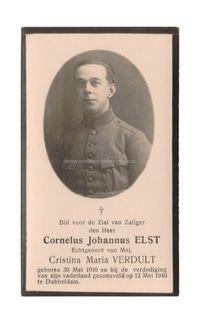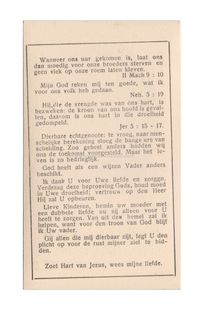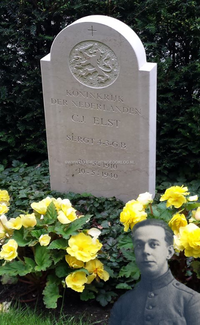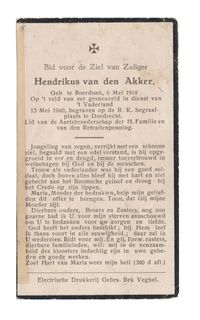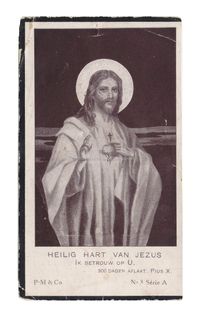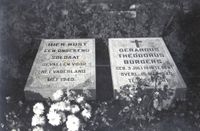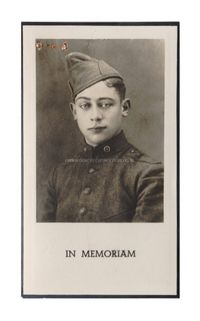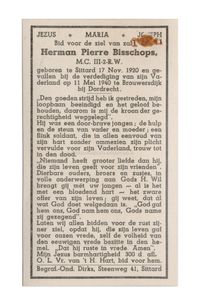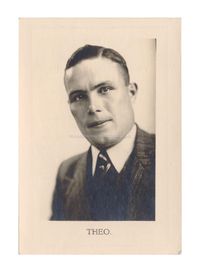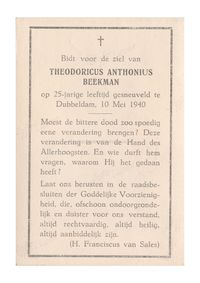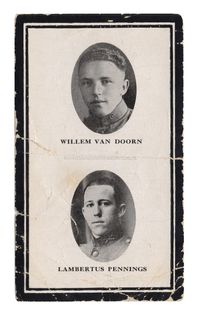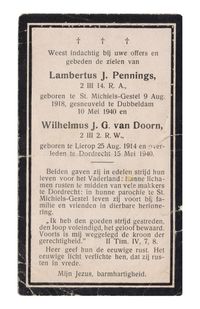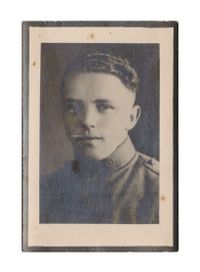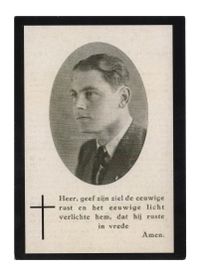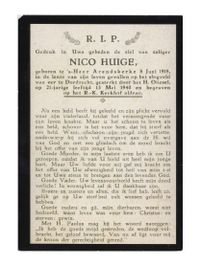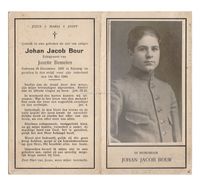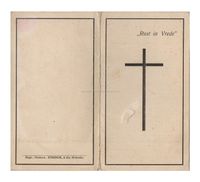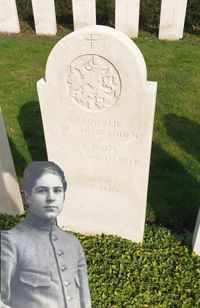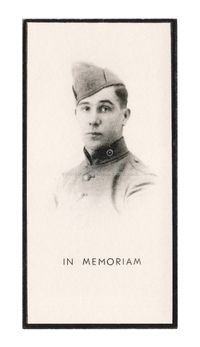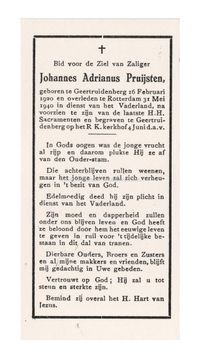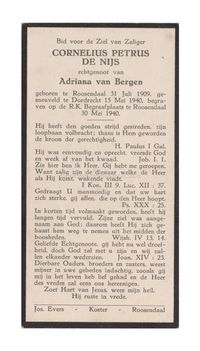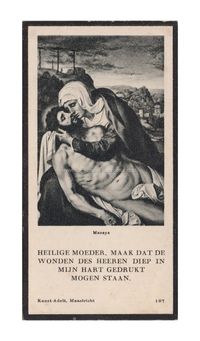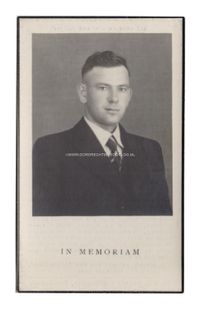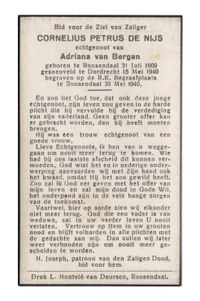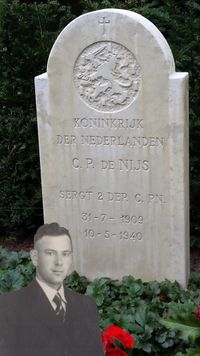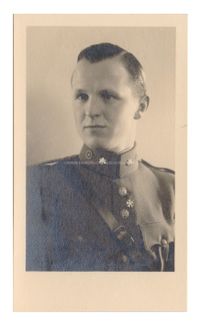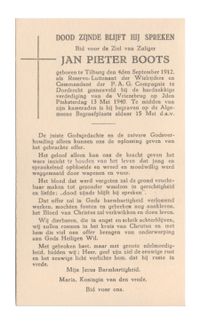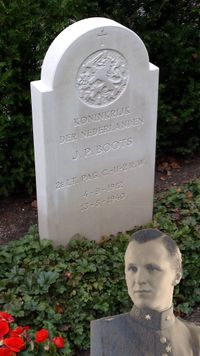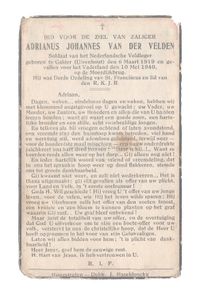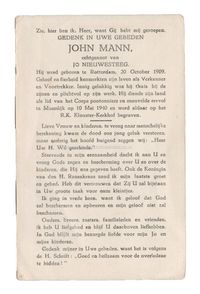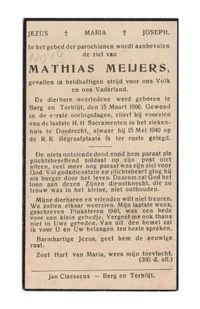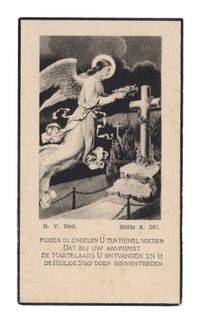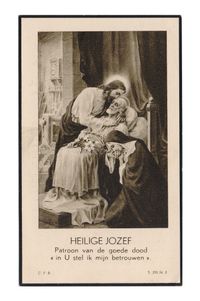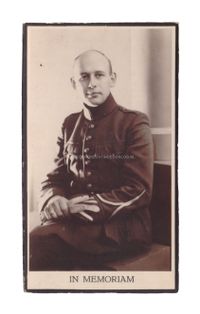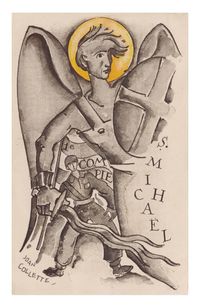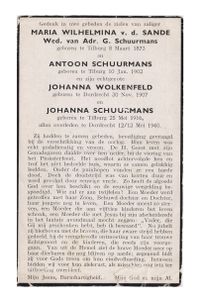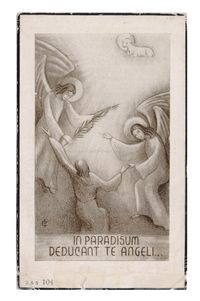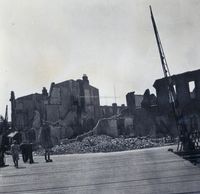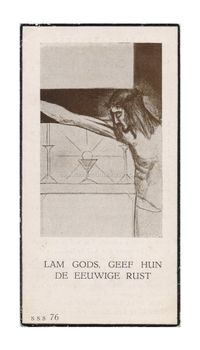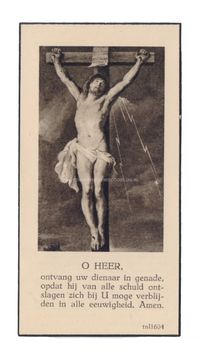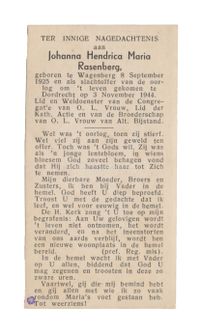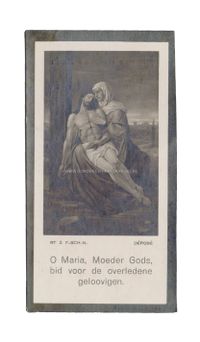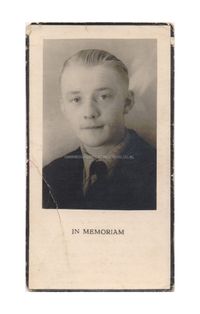Deathcards Dutch .
During the war, many soldiers died as it progressed. To commemorate these soldiers, so-called deathcards or in German, "sterbebilder" were often printed. Both on the Dutch side, shortly after May 1940, and on the German side, these deathcards were used. Civilian casualties were also often depicted on a deathcard.
The deathcards often included the name of the respective soldier, the date and place of death, and sometimes the cause of death. It was not uncommon for the rank and any military medals of the soldier to be mentioned, as well as the final resting place. For German soldiers, the final resting place was often the same as the place of death. Meanwhile, Dutch soldiers were often buried in their hometowns.
Deathcards of military personnel.
Sergeant Cornelis Johannes Elst.
Sergeant Elst was part of the 4th company of the 3rd Grens Bataljon (4-3.GB) ( Border Batalion ). The unit was tasked with capturing the pumping station between Tweede Tol and Wieldrecht on the morning of May 12, 1940. The pumping station, along with its lock, could then be demolished to flood the west side of the island of Dordrecht, which would provide a tactical advantage for the Dutch defense of Dordrecht according to the Staf Kil. The pumping station, which was closer to Tweede Tol and the German positions than to Wieldrecht and the Dutch positions, was fiercely defended by the Germans. Adjacent to the pumping station was a farmhouse estimated by Reserve 1st Lieutenant Gouverneur to be defended by approximately eight Germans. The Dutch soldiers attempted to drive the Germans out of the farmhouse with hand grenades, but were unsuccessful, resulting in casualties on the Dutch side. When the hand grenades were depleted and most of the ammunition had been fired, the section retreated, during which Sergeant Elst was struck in the forearm and abdomen. He passed away shortly after sustaining his injuries. *1
Officially, Sergeant Elst is buried at the Military Cemetery Grebbeberg. However, the website Zuidfront-Holland1940 makes an interesting mention that it is not Sergeant Elst buried in this grave, but Corporal Bunder. According to this information, Sergeant Elst is believed to be buried in an unknown grave in Dordrecht. *2
Conscript private Hendrikus van den Akker.
Conscript private Hendrikus van den Akker was part of 3-III-14 R.A. According to military historians De Leeuw and Brongers, the soldier was killed on May 10, 1940, near the railway. However, the War Graves Foundation states his date of death as May 12. His prayer card, on the other hand, indicates May 13 as the date of death. The late Mr. Jan van der Vorm conducted research on his death and concluded that conscript soldier van den Akker moved to the city center of Dordrecht as a passenger after the battles in Dubbeldam. He then reported to Lieutenant J.P. Boots and was assigned to the 7-Veld artillery piece on the Vriesestraat. This artillery piece was under the command of Sergeant Otto Kruithof from 4.II KRA (Korps Rijdende Artillerie, i.e. Corps Motorized Artillery). In his report, he describes being joined by an unknown field artilleryman. After positioning the artillery piece at the Vriesestraat, near the bridge, machine gun fire was directed at the artillery piece from the "arbeiderspers" printing house (building "De Voorwaarts"). This machine gun fire was silenced with two shots fired at the building. After a while, German tanks appeared, leading to an exchange of fire between the 7-Veld artillery piece and the German tanks. During this engagement, soldier Burgers from 4-II-K.R.A. and the unknown field artilleryman were killed. *3
A quote from the report on the events of May 13, 1940, in Dubbeldam (Bieschbos) and Dordrecht (Vriesestraat) by Sergeant Otto Kruithof of 4-II-K.R.A., as described in the service letter of May 9, 1941 (as published on the website: www.zuidfront-holland1940.nl/Dordt )
"For the third time, I attempted to load, but Eijkelenberg was unable to open the breech. It was stuck tight, and as I looked back to grab the handle on the left side of the carriage, known as the "aanzetter," in order to open the breech, I noticed with horror that numbers 3, Burgers, and 4, the unknown field artilleryman, who had been kneeling by the tail of the gun, were lying on the ground in pools of blood. A shell had killed them both." *4
Private Burgers was posthumously awarded the Bronze Cross on May 6, 1945, for his courageous actions in the Vriesestraat. Soldier van den Akker, presumably due to being an unknown soldier and not being named in combat reports, did not receive this honor. Although it is not proven, it is highly likely that Soldier van den Akker was killed while defending the Vriesestraat.
Both soldiers were initially buried at the Cemetery in Dordrecht. In the photo below, also posted elsewhere on this website, you can see the grave of Soldier Burgers, as well as the grave of an unknown soldier, conscript private van den Akker.
Conscript private Herman Pierre Bisschops.
Conscript private Herman Pierre Bisschops was part of the Machine Gun Company of III-2 Regiment Wieldrijders (MC. III-2. RW) ( Military Bicycle Infantry). III-2.RW arrived in Dordrecht on the night of May 10-11, 1940. The machine gun company was subsequently divided among the other companies, which led to private Bisschops being assigned to reinforce 2-III-2RW, as ordered by the Battalion Commander (BC). The 4th section, under the command of Ensign Blok, had little information recorded in the combat reports regarding their specific objective. Only that the section had been instructed to position themselves in the northwestern corner of Krispijn to secure the neighborhood.
It is confirmed, however, that for some unknown reason, in the morning of May 11th, the 4th section drove onto Weeskinderendijk, directly towards the positions of the German paratroopers. The website Zuidfront-Holland1940/Dordt suggests that the section took a wrong turn at Hugo de Grootplein. Regardless of the reason, the soldiers of the 4th section MC. III-2. RW had no idea of the fatal mistake they were about to make. They drove straight into German fire. Some motorcycles caught fire, and within a short time, six soldiers were killed, and four were severely wounded. Due to the motorcycles catching fire from the German gunfire, some of the deceased soldiers were severely burned.
The fallen soldiers were as follows *5:
Reserve Ensign C.J.P. Blok.
Conscript Sergeant J.J.E. van der Korput.
Conscript private W.C. Fransiscus.
Conscript private H. Philippen.
Volunteer private H. Kerkwijk.
And Conscript private: Herman Pieter Bisschops.
Conscript private Theodoricus Anthonius Beekman.
Conscript private Theodoricus Anthonius Beekman was part of the Machine Gun Company of I-28 Infantry Regiment (MC-I-28 R.I.). He was stationed in Amstelwijck on May 10, 1940. He was on guard duty and was killed near the stables during the action led by Leutnant Graf von den Blücher. Apart from the information provided on the website Zuidfront-Holland1940, nothing else is known about his death. Private Beekman died at the age of 25. He is buried at the military cemetery the Grebbeberg. *6
Conscript private Lambertus Pennings.
Conscript private Lambertus Pennings was part of 3-III-14 Regiment Artillery. The unit's positions were located near the Zeedijk. When German paratroopers landed on May 10th, it was right in between the positions of III-14 R.A. A few guard posts near the artillery pieces were quickly overwhelmed, and the pieces were captured by the paratroopers. Meanwhile, the staff of III-14 R.A. had gathered at the command post in the school near the cemetery on the Zuidendijk. It was decided to launch a counter-attack and recapture the pieces. A battle quickly ensued near the intersection of the Schenkeldijk and Zeedijk. After attempting several actions at this intersection with significant losses among the Dutch officers, a withdrawal was made to the Zuidendijk.
From the Zuidendijk, Captain Mulder led a few soldiers from the third battery towards Wielwijk, heading towards the railway embankment. The goal was to reach and recapture the unit's positions via the west, alongside the railway tracks. However, a group of paratroopers had entrenched themselves near the railway embankment, resulting in another firefight. The paratroopers allowed the Dutch soldiers to approach at close range before opening fire. Several soldiers were wounded and incapacitated by gunshot wounds. Private Pennings was fatally hit and killed during this firefight. Although the Germans were driven out of the house from where they opened fire, the group of Dutch soldiers retreated back to the Zuidendijk. Private Pennings died on May 10th at the age of 21. He is buried at the Military Cemetery de Grebbeberg. *8
Conscript private Wilhelminus Johannes Gerhardus van Doorn.
Conscript private Wilhelminus Johannes Gerhardus van Doorn was part of 2-III-2 Regiment Wielrijders (Bicycle Infantry Regiment). The exact circumstances of his death are unclear. According to the source, the website Zuidfrontholland1940, it is probable that soldier van Doorn was injured on the Oudendijk in a battle with German troops from Gruppe de Boer on May 12, 1940 near the General Cemetery, or German paratroopers in the western direction. However, historians Brongers and de Leeuw suggest that soldier van Doorn was wounded at the railway crossing in Dubbeldam on May 11, 1940. This is questionable, as 2-III-2 R.W. did not have any casualties or wounded that day. What is certain is that soldier van Doorn suffered a stomach wound and died on May 15, 1940 in the hospital as a result of that wound. *9
Conscript private Nicolaas Huige.
Conscript soldier Nicolaas Huige was a part of the troop detachment of the headquarters of the Lichte Divisie (Light Division). At some point, soldier Huige is said to have joined the artillery of Wachtmeester Kruithof from the K.R.A. (Corps Motorized Artillery) as an assistant. The artillery was hit by a German tank and soldier Huige was severely injured in the process. He was subsequently transferred to the Roman Catholic hospital in Dordrecht, where he passed away on May 13th due to his injuries. *10
Conscript private Johan Jacob Bour.
Conscript private Johan Jacob Bour was born on December 18, 1910 in Schaesberg in South Limburg, the Netherlands. He worked as a miner until he was called up for military service and joined the 2nd School Company of the Corps of Anti-Aircraft Artillery in Utrecht on January 2, 1930. In June 1938, he was transferred to the 2nd Regiment of Anti-Aircraft Artillery during a reorganization, and during the mobilization, he became a part of the 85th platoon of anti-aircraft machine guns. The 85th and 86th platoons together formed the air defense point at Zwijndrecht. The 86th platoon was stationed on the Zwijndrecht side of the bridges, while the 85th platoon was on the Dordrecht side. On May 10, 1940, when the war broke out in the Netherlands, German paratroopers from 3./FJR 1 landed in the meadows near Krispijn and in Zwijndrecht. The German paratroopers who landed in Zwijndrecht quickly advanced towards the bridges over the Oude Maas and first neutralized the 86th platoon of anti-aircraft machine guns. Meanwhile, the 85th platoon continued to fight and tried to resist the advancing paratroopers. However, the paratroopers had excellent cover from the thick steel bridge walls and managed to approach the positions of the 85th platoon at close range. In the ensuing battle, conscript private Bour was killed in the early hours of May 10, 1940. He was 29 years old and is buried at the General Cemetary in Dordrecht. *12
Conscript private Johannes Adrianus Pruijsten.
Conscript private Johannes Adrianus Pruijsten was born on February 16, 1920 in Geertruidenberg. At a young age, he enjoyed drawing and painting. He was a sporty young man who loved playing football and cycling. On October 23, 1939, Soldier Pruijsten reported for duty as a regular conscript and received basic training at the Depot Wielrijders ( Depot Bicycle Infantry ) in Gouda. After February 15, 1940, he was assigned to the 2nd Regiment Wielrijders. When the war broke out on May 10, 1940, the 2nd Regiment Wielrijders also received its marching orders. On May 13, 1940, Soldier Pruijsten and his unit were at the intersection of the Zeedijk/Schenkeldijk, preparing for a counterattack as part of the Light Division. However, the Germans launched their own attack on the intersection, bringing about 20 tanks from the 9th Panzer Division over the Zeedijk. Before the resistance was broken, Stuka dive bombers carried out an attack on the Dutch positions. Soldier Pruijsten was severely wounded in these battles and left behind by the fleeing Cyclists Infantry. He was found by German soldiers and taken to the Zuiderziekenhuis in Rotterdam, where one of his legs and an arm were amputated. On May 31, 1940, conscript soldier Johannes Adrianus Pruijsten succumbed to his injuries. He was buried in Geertruidenberg, where he still rests today in a war grave. *13
Conscript Sergeant Cornelis Petrus de Nijs.
Conscript Sergeant Cornelis Petrus de Nijs was born on July 21, 1909, in Roosendaal. He served in the 2nd Depot Company of the Korps Pontonniers en Torpedisten ( Army Maritime Engineers Corps ). On the morning of May 10, 1940, as part of a group of soldiers with the strength of a half company under Lieutenant Brouwer, he was deployed in a counterattack against German paratroopers near the bridges over the Oude Maas. The depot troops were pushed back and suffered some casualties, including Lieutenant Brouwer. Some troops withdrew to the Sportfondsenbad, including Sergeant de Nijs. From the Sportfondsenbad, they maintained contact with the paratroopers at the bridges by exchanging fire. Sergeant de Nijs was killed during one of these firefights. Initially, he was buried at the Roman Catholic Cemetery in Roosendaal, but he has since been reburied at the Military Cemetery de Grebbeberg in Rhenen. *15
Reserve Second Lieutenant Jan Pieter Boots.
Reserve Lieutenant Jan Pieter Boots was born on September 4, 1912, in Tilburg and served in the PAG - II-2 R.W. (Anti-Tank Artillery 2nd Company 2nd Bicycle Infantry Regiment). On May 13, 1940, the Lieutenant was involved in the defense of the Vriesebrug. The PAG was positioned next to the cantonment hospital alongside the 7-Veld gun of Wachtmeester Kruithof. When two German tanks attacked the Dutch positions at the Vriesebrug on May 13, Lieutenant Boots was killed by fire from one of the German tanks. He died from shrapnel that entered beside his nose. *16
Reserve Lieutenant Jan Pieter Boots is buried at the Military Cemetery de Grebbeberg in Rhenen, in row 15, grave 37.
Conscript private Adrianus Johannes van der Velden.
Conscript private Adrianus Johannes van der Velden was born on March 6, 1919, in Ginneken, North Brabant. He served in the Dekkingsdetachement Willemsdorp ( Covering Detachment Willemsdorp) as part of the 6th Infantry Regiment. On the morning of May 10, 1940, soldier van der Velden was likely part of the bridge guard. He encountered German paratroopers and was killed in action. His body ended up in the Hollandsche Diep from the Moerdijk Bridge. His body was recovered from the water only a year later. He was initially buried as an unknown soldier because his remains could no longer be identified. However, in 1999, through DNA analysis conducted by the Recovery and Identification Service of the Royal Netherlands Army, it was determined that the body was that of van der Velden. *17
Conscript private van der Velden is buried in the honorary row at Dubbeldam Cemetery in grave 24.
Conscript private Johannes Hendrik Lorenz Philip Mann.
Conscript Soldier Johannes Hendrik Lorenz Philip Mann was born on October 20, 1909 in Rotterdam. He served with the Volunteer Landstorm Corps 1st Ferry Group - Ferry 2C. This unit was located in the port of Moerdijk and operated the ferry service between Moerdijk and Willemsdorp. The unit also carried out surveillance tasks on the water. On May 10, 1940, German paratroopers landed in the vicinity of Moerdijk, leading to the military personnel of the Ferry Group becoming involved in combat. Captain Janssen, the commander of the Ferry Group, instructed seven Pontonniers ( Army Maritime Engineers ) to defend the harbor so that the ships and crew could escape. The Pontonniers who remained behind were the soldiers: Van der Hooft, Mann, Vlot, Brondsema, Van Houdt, Ruissen, and Van der Plas. Van der Hooft, Mann, and Vlot were killed in action while defending the harbor. The remaining soldiers were captured. They were all posthumously decorated. Soldier Mann was awarded the Bronze Cross by Royal Decree on March 17, 1947:
"He distinguished himself by courageous actions against the enemy, as in the early morning of May 10, belonging to a small detachment of the Ferry Group 2C [sic], which, as a result of the sudden attack by landed enemy paratroopers, was tasked with defending the immediate vicinity of the harbor at Moerdijk to cover the crossing of this ferry group to Willemsdorp, fearlessly holding his ground despite receiving intense enemy fire from various directions at close range, until he ultimately fell in combat." *18
Conscript Soldier Mann is buried in the Field of Honor at the General Cemetery in Dordrecht, in row 5, grave 3.
Conscript Corporal Mathias Meijers.
Conscript Corporal Mathias Meijers was born on March 15, 1906 in Berg en Terblijft in Limburg. He served with the 2nd company of the 1st battalion of the 2nd Regiment Wielrijders (2-I-2 R.W.) ( Bicycle Infantry Regiment ) . The company arrived in Dordrecht on May 11, 1940, and was located on May 13, 1940, near the intersection at the Zeedijk. Two bicycle infantry battalions, namely III-2 R.W. and I-2 R.W., were ordered to launch a counterattack along and over the Zeedijk towards the Tweede Tol. They were still forming in attack positions when German tanks came driving over the Zeedijk and began shelling the intersection at Zeedijk - Elzelingenweg. Additionally, the bicycle infantry soldiers were also bombed by Stuka dive bombers. The sudden attack of German tanks and the air bombardments by the Stukas caused confusion among the bicycle infantry soldiers. Conscript Corporal Meijers was seriously wounded in the German tank attack on the Zeedijk. He was transported to the Roman Catholic hospital in Dordrecht and succumbed to his injuries there on May 15, 1940.*19
Conscript Corporal Meijers is buried at the Cemetery in Loenen in row C grave 49.
Conscript Private Wilhelmus Adrianus de Leeuw.
Conscript Soldier Wilhelmus Adrianus de Leeuw was born on December 3, 1904, in Lage Zwaluwe. He was part of the 3rd Section of the 2nd Road Company Battalion Railway Troops (3e Sie 2e Wgcie Bat Spw Tr.). This unit was stationed in Dordrecht during the mobilization and was tasked with guarding the station, railway bridge, and railway yard of Dordrecht. The unit was also responsible for making the railway bridge passable with motor vehicles for the potential evacuation of the Field Army from North Brabant. The railway troop section was billeted in Villa Weizigt in Krispijn, near the railway tracks. In the early morning of May 10, 1940, the main force of the 3rd company of Fallschirmjäger Regiment 1 (3./FJR 1) landed in the polder in Krispijn. They immediately engaged in combat with the Railway Troops. One platoon of 3./FJR 1 landed in Zwijndrecht and attacked the Zwijndrecht bridges via Zwijndrecht. Conscript Soldier de Leeuw was part of a three-man guard post on the railway bridge between Zwijndrecht and Dordrecht. He was killed at the bridge guardshouse during a brief skirmish with paratroopers from 3./FJR 1. *20
Conscript Soldier de Leeuw is buried at the Roman Catholic cemetery Laurentius in Breda in row 20 - grave 8.
Conscript private Johannes Adrianus van Dorst.
Conscript soldier Johannes Adrianus van Dorst was born on May 16, 1918 in Bergen op Zoom. He was part of the 4th Company of the 3rd Border Battalion (4-3 G.B). This unit only appeared on the battlefield in Dordrecht on May 12, 1940. Soldier van Dorst belonged to the "Gouverneur"Section under the lieutenant Gouverneur. In the morning of May 12, the company crossed the Wieldrecht Ferry with three sections to establish a bridgehead in support of the Light Division. The 1st section was tasked with holding Wieldrecht, the 2nd section under Lieutenant Gouverneur would advance via the dike to the steam pumping station between Wieldrecht and the Tweede Tol. The 3rd section was ordered to secure the immediate vicinity at the Wieldrecht Ferry. Conscript soldier van Dorst was killed in action during the fighting of the 2nd section near the motor steam pumping station. A number of German paratroopers had entrenched themselves in a farmhouse there. In the ensuing firefight, soldier van Dorst was killed. *21
Conscript soldier van Dorst is buried at the Roman Catholic Cemetery Bergen op Zoom 'Lepelstraat' in OGS grave 232.
Conscript soldier Hubertus Cornelis van Dongen.
Conscript soldier Hubertus Cornelis van Dongen was born on December 12, 1910 in Dongen. He was part of the 1st Company of the III Battalion of the 2nd Regiment Cyclists (1-III-2 R.W.). Soldier van Dongen was taken prisoner of war, presumably when German paratroopers under the command of Hauptmann Schulz captured several Dutch officers by deceit near the Zeehavenviaduct. Among the officers were Major Ravelli (commander of the Ravelli battalion) and Captain Wijers (commander of 1-III-2.RW). Both officers wanted to prevent Dutch troops from firing upon each other, as had already happened earlier that morning, and had moved forward when they saw a truck with Dutch soldiers near the Zeehavenviaduct. They were captured when German paratroopers emerged and used the Dutch troops in and behind the truck as a ruse, capturing the two officers and several other Dutch soldiers. Conscript soldier van Dongen was interned as a prisoner of war in the school with the Bible on Admiraal de Ruyterweg. When Dutch artillery from 23 R.A. targeted the school, soldier van Dongen lost his life. *22
Conscript soldier van Dongen is buried at the Military Cemetery Grebbeberg in Row 9 - Grave 2.
Conscripted sergeant Christiaan Marie André Hardus.
Conscripted sergeant Christiaan Marie André Hardus was born on July 30, 1914, in Bergen op Zoom. He was part of the 4th company of the 3rd Border Battalion (4-3 G.B.). On the morning of May 12, the company crossed the Wieldrechtse Veer with three sections to form a bridgehead in support of the Light Division. The 1st section was to occupy Wieldrecht, the 2nd section under Lieutenant Gouverneur was to advance along the dike to the steam pumping station between Wieldrecht and the Tweede Tol, and the 3rd section was tasked with securing the immediate vicinity of the Wieldrechtse Veer. Conscripted sergeant Hardus was severely wounded by mortar fire while disembarking from the ferry. He died of his injuries on May 15, 1940, in 's Gravendeel.*23
Conscripted sergeant Hardus is buried in the old general cemetery in 's Gravendeel in row D2 - monument grave 86.
Company Commander Jacobus Andreas Beekman.
Jacobus Andreas Beekman was the company commander of the 1st company of the Strijdende Gedeelte (S.G.) of the Binnenlandse Strijdkrachten
( fighting part of the Dutch domestic forces ) in Dordrecht during World War II. After completing many dangerous missions with his troops during the war, it was tragic that he lost his life in an accident after the war ended.
A civilian had reported with the head of a German Panzerfaust (anti-tank weapon) to the Bewakingstroepen (Security Forces), which needed to be made safe. Beekman, as a reserve 1st Lieutenant of the Genietroepen (Engineer Troops), had undergone a course on explosives. He picked up the explosive from the Bewakingstroepen and then drove with the platoon commander Gerritse and the section commander Aan de Wiel to the barracks of the 1st company S.G. Together, they went to the Vlijweg to detonate the projectile. Unfortunately, tragedy struck and Beekman and Gerritse were killed instantly. Aan de Wiel was critically injured and taken to the Gemeente Ziekenhuis (Municipal Hospital), where he stated that he suspected Blitzkoord had been used instead of Vuurkoord, which would have had a much faster ignition. This may have been the cause of the accident. Section commander Aan de Wiel succumbed to his injuries the following morning on June 9, 1945. All of them are buried in the military section of the Essenhof cemetery in Dordrecht.*14
Deathcards of civilian casualties.
The Schuurmans family,
The Schuurmans family lived at Dubbeldamseweg 29 in May 1940. At least the following individuals were living at that address:
- Maria Wilhelmina Schuurmans van der Sande (widow of Adrianus Gerardus Schuurmans).
- Antonius Theodorus Schuurmans (son of the above-mentioned individuals).
- Johanna Fransisca Schuurmans Wolkenfelt (wife or partner of Antoon Schuurmans).
- Johanna Maria Antonia Schuurmans (daughter of M.W. van der Sande and A.G. Schuurmans, and sister of Antoon Schuurmans).
The Schuurmans family perished on 12 or 13 May 1940 due to the war violence during the May 1940 in Dordrecht. Mrs. C.J.W. de Koff describes on the website www.zuidfront-holland1940.nl/dordt what happened on 12 May 1940 on Dubbeldamseweg:
In the afternoon of 12 May, they were taken out of their homes by German soldiers. There was a dead German soldier in the entrance, and the Germans believed that shots had been fired at them from the houses on Dubbeldamseweg. The houses were searched, and the civilians from Dordrecht were also frisked. Meanwhile, they found Dutch cartridge cases in Evert's, Mrs. de Koff's younger brother, pocket which he had found on the street, escalating the situation. A German soldier threw an incendiary bomb into the Schuurmans' house (number 29).
Despite the neighbor's shouts that there was still a disabled woman inside, Evert was pressed against the wall, and a German soldier aimed his weapon at him to shoot him. Before he could do so, he was shot dead by Dutch soldiers across the railway. Suddenly, the conflict broke out, with innocent civilians caught in the middle. Mrs. de Koff then describes that she, Annie, and Johanna were forced by the Germans into a cigar shop, and the Germans used them as cover for a cannon they set up. The Dutch soldiers no longer fired. By Johanna, she probably means one of the Johannas from the Schuurmans family. She herself tries to escape and is shot at but survives with relatively minor injuries. She does not mention the Schuurmans family further in her account. They all die either on 12 May or on 13 May. Photos of the affected houses after May 1940 show them completely destroyed. Either they were burned down by German hand grenades or by Dutch artillery, the latter seems most likely given the significant war damage. From Mrs. de Koff's story, it appears that only one woman was inside when the hand grenade was thrown inside. Since it was the neighbor who shouted this, it was probably Antoon. She also describes being taken away with a group of about 25 people through Mauritsweg and Sophiastraat. Presumably, the Schuurmans family returned to their home after the events and perished due to Dutch artillery fire. However, these are assumptions. It is certain that the Schuurmans family died as a result of the war violence in May 1940. But how exactly, that remains a mystery. *11
The destroyed residential houses on Dubbeldamseweg.
Helena and Jacobus Reiniers.
Above you see the deathcard of Helena Cornelia Reiniers and Jacobus Reiniers. Helena was born on June 29, 1918, in Moerdijk. Her younger brother Jacobus was born on April 4, 1922. Both were killed in May 1940 in Moerdijk.
In May 1940, heavy fighting took place in Moerdijk, especially on May 10. Leentje and Koos were the daughter and son of Mr. Reiniers, who was the operator of the steam pumping station on Zwaluwsedijk in Moerdijk, just outside the village near the Moerdijk bridges. German paratroopers landed near the pumping station. Awakened by the noise of the aircraft and the sounds made by the paratroopers, they got out of bed and went into the kitchen. The paratroopers heard movement, and suspecting the presence of Dutch soldiers, immediately opened fire as they entered. Koos was killed instantly, and Leentje died three days later. Both had gunshot wounds to the chest.
Jacobus died on May 10, 1940, at the age of 18, and Helena three days later on May 13, at the age of 21. Both were buried in a mass grave in the Monastery Garden. The graves have likely since been cleared.
Gommair Joannes Alphonsius Franciscus van Eijsden.
Gommair Joannes Alphonsius Franciscus van Eijsden was born on September 21, 1890, in Dordrecht. He was Roman Catholic and married to Catharina Rademaker. They lived at Hendrikstraat 6 red in Dordrecht. Gommair was a distribution officer by profession. He was arrested on October 26, 1943, for 'Judenbegünstigung,' or helping Jews, and transferred to the Befehlshaber der Sicherheitspolizei und des SD in The Hague. He was assigned to the external command camp in Moerdijk on March 2, 1944, after having arrived at Kamp Vught on November 10, 1943. After his stay at the external command camp in Moerdijk, he was transported to Dachau on (24?) March 1944. Gommair died there on February 5th 1945, presumably from typhus. His body was cremated in the crematoriums of Dachau. One of the many who would never return home from Dachau.*24
Joannes Joseph Maria Bröcker en Maria Aleida Louise Bröcker.
Joannes Joseph Maria Bröcker was born on June 4, 1903, in Dordrecht. He was married to Yvonne Jeanne Maria Josepha Vercauteren. Together, they had a daughter named Maria Aleida Louise. Joannes and Maria both perished in an internment camp in Bangkinang in the Dutch East Indies. Joannes passed away on April 25, 1945. Maria, at the age of 10, passed away in the women's camp on February 1, 1944. Both have graves at the Dutch War Cemetery in Leuwigajah, Indonesia. Joannes rests in plot I, grave 662, while Maria rests in plot VII, grave 48.
Johanna Hendrica Maria Rasenberg.
Johanna Hendrica Maria Rasenberg was born in Wagenberg on September 9, 1925. She was the daughter of Johannes Rasenberg and Anna Huijgens. Johanna lived in Terheijden. On November 3, 1944, she lost her life in Dordrecht as a victim of the war. The circumstances of her death remain unclear.
Gerardus Steen.
Gerard Steen was born on January 26, 1925, in Dordrecht. He earned his MULO diploma in Amsterdam in 1941. In September of that year, he entered the Juvenate of the Brothers of Saint Aloysius in Oudenbosch, aspiring to become a teaching brother. However, he returned home later that year after realizing he was not suited for monastic life. In 1942, he became a trainee clerk at the Direct Tax Collection Office in Amsterdam. He was called up for six months of service in the Dutch Labor Service. In September 1944, Steen began engaging in illegal activities with the Knokploeg (armed resistance group) of the Domestic Forces in Amsterdam. He even resigned from his job to do so. His tasks included courier services, transporting weapons, and offering his room in his parental home for weapons instruction.
When the Sicherheitspolizei raided the home of a platoon commander, they discovered a large number of identity tags intended for use after liberation. The address had been betrayed by an arrested resistance member. This discovery led to multiple raids on members of the Amsterdam Domestic Forces. In Gerard Steen’s home, a Sten gun and ammunition were found. He was imprisoned in the Detention Center on Weteringschans and placed on a list of death candidates.
On April 15, 1945, Gerard Steen was executed in Sint Pancras along with nineteen other resistance members as a reprisal for an attack on a German train. Their bodies were buried in a mass grave in the dunes near Overveen. Today, he is buried at the Honorary Cemetery Bloemendaal in Overveen, in Section 21. *25
Adrianus van het Hoofd.
Adrianus van het Hoofd was born on 5 April 1923 in Dordrecht. He was the son of Machiel van het Hoofd and Klaartje Duijzers. Adrianus worked at the Victoria factory in Dordrecht as a factory laborer. In the second week of June 1942, he was sent by the German occupier to Germany for forced labor (Arbeitseinsatz). He ended up in Ludwigsfelde. This was the location of, among other things, the Daimler-Benz factory in Ludwigsfelde. The factory was established in 1936 by Daimler-Benz AG in Ludwigsfelde, just south of Berlin, with the purpose of producing aircraft engines for the Luftwaffe. During the war, it produced, among others, the DB 600, DB 601, DB 603, and DB 605 engines, which were used in bombers and fighter aircraft. At least 10,000 forced laborers, prisoners of war, and concentration camp inmates worked under appalling conditions in the factory. It is possible that Adrianus was employed at this factory, although no conclusive evidence has yet been found.
Adrianus died on 27 July 1942 under unknown circumstances in Ludwigsfelde. He was buried on 5 August at the Roman Catholic cemetery in Dordrecht, in section CL, row 1, grave 16. In April 1962, the remains of Adrianus van het Hoofd were reinterred at the National War Cemetery in Loenen. He is buried there in section A, grave 460.
©2017-2026 :Https://www.Dordrechtindeoorlog.nl: ( There is a copyright on the content of this website. This content is not to be shared, duplicated or published withouth the explicit permission of the author of this website. If you have any requests you can email to: Info@Dordrechtindeoorlog.nl or look on : www.dordrechtindeoorlog.nl/termsofuseforthecontentonthiswebsite.
*1 Source: De verrichtingen van 4-3.GB in Wieldrecht op 12 mei 1940 - Zuidfront-Holland1940.nl
*2 Source: C.J. Elst Zuidfront-Holland1940.
*3 Source: H.van den Akker Zuidfront-Holland1940.
*4 Source: Zuidfrontholland1940/Dordt - IIe afdeling K.R.A.
*5 Source: Zuidfrontholland1940- Vak Wieldrecht - 2e fase - een zinloos offer.
*6 Source: Zuidfrontholland1940- Beekman.
*7 Source: Zuidfrontholland1940- Vak Wieldrecht 1e fase - III-14 R.A.
*8 Source: Zuidfrontholland1940- Pennings.
*9 Source: Zuidfrontholland1940- van Doorn.
*10 Source: Zuidfrontholland1940- Huige.
*11 Source: Zuidfrontholland1940.Dordt. - Dordt Open Stad- Dubbeldamseweg.
*12 Source: Zuidfrontholland1940- Bour.
*13 Source: Zuidfrontholland1940- Pruijsten.
*14 Source: Verzet in en om Dordrecht - K van Loon. "Rapport betreffende ongeval met dodelijke afloop in den avond van 8 juni 1945" Bladzijde 261
*15 Source: Zuidfrontholland1940- Nijs.
*16 Source: Zuidfrontholland1940- Boots.
*17 Source: Zuidfrontholland1940- van der Velden.
*18 Source: Zuidfrontholland1940 - Mann.
*19 Source: Zuidfrontholland1940 - Meijers.
*20 Source: Zuidfrontholland1940 - De Leeuw.
*21 Source: Zuidfrontholland1940 - van Dorst.
*22 Source: Zuidfrontholland1940 - van Dongen.
*23 Source: Zuidfrontholland1940 - Hardus.
*24 Source: https://collections.arolsen-archives.org/GommairvanEijsden en https://www.nationaalarchief.nl/GommairvanEijsden
*25 Source: www.vrijheid.scouting.nl - Gerard Steen
